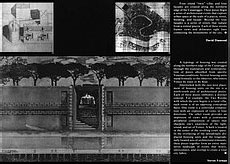 Student Projects
|
In 1967 the College of Architecture became the College of Architecture,
Art, and Planning. During this period Cornell achieved national and international
prominence, resulting from a combination of the liberal educational philosophy of
President James Perkins and Dean Burnham Kelly, the talented and energetic faculty, a more
diverse student body, and Cornell’s long tradition of excellence. Innovative programs
like Colin Rowe’s Urban Design Studio enriched the curriculum. The College prepared
students for a changing profession, one that included the application of the social
sciences, the shift of focus from the construction of individual buildings to the whole
building process, the evolution of design methodology, and the revival of large-scale
design. In general, architects designed less and less for individuals; the client was now
society at large. In the next decades, under the direction of Deans K.C. Parsons, Jason
Seley, and William McMinn, the College expanded outside Ithaca with programs in
Washington, D.C. and Rome. New courses included preservation planning, the architectural
aspects of archaeology, social planning, urban environmental policy, and community
development. The fine arts course provided intensive studio experience in painting,
sculpture, photography, and the graphic arts. By the 1980s computers became ubiquitous,
with the advent of courses in computer-aided design, microcomputer applications, and
computer art. While retaining its basic mission, the College initiated new programs in the
1990s which further emphasized the application of technology, diversity, and a greater
cultural and social awareness.
Today the College of Architecture, Art, and Planning continues to fulfill the mission
set out by Andrew Dickson White. Over the years its programs have given life to Ezra
Cornell’s ideal of combined liberal and practical study. Other architecture schools
have emulated Cornell’s programs, major architectural firms have used the principles
formulated at Cornell, and the College’s alumni have used these ideals to change the
face of the built environment. |

